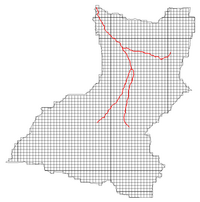Template:GSSHA 2D UGrid Tool
From XMS Wiki
This is the approved revision of this page, as well as being the most recent.
Jump to navigationJump to search
GSSHA 2D UGrid
Given a coverage and cell size, creates a rectilinear 2D UGrid with a cell-based elevation dataset, numbered the GSSHA way, with cells outside the domain inactivated. Cells are numbered starting in the top, left corner, in row-major order. An elevation raster can be used when computing cell elevations. Stream elevations can be included in the calculation of the cell elevation dataset.
Input Parameters
- Input GSSHA Boundary Conditions coverage – The GSSHA Boundary Conditions coverage. The grid extents will be determined from the coverage extents. If a stream network exists, the stream elevations can be included when computing the cell elevation dataset (see “Include streams in cell elevations” below).
- Cell size – Width and height of the cells. Cells are always square. A default value is provided that will result in 60 cells in the direction (X or Y) with the smallest length.
- Output grid name – Name of the grid to be created. Optional.
- Get cell elevations from raster – Option to use an elevation raster when computing the cell-based elevation dataset. The raster value at the cell center is used, without interpolation.
- Raster – The elevation raster if the Get cell elevations from raster option is selected.
- Include streams in cell elevations – If selected, and the boundary conditions coverage contains stream arcs, the arcs are intersected with the grid and intersected cells are assigned the elevations of the arcs based on a weighted average of the intersected portion of the arc in the cell.
Output Parameters
- UGrid – The new UGrid that will be created.
Current Location in Toolbox
GSSHA | GSSHA 2D UGrid

